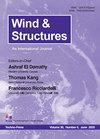钝尾缘厚度对特厚翼型气动特性的影响
IF 1.9
4区 工程技术
Q3 CONSTRUCTION & BUILDING TECHNOLOGY
引用次数: 0
摘要
本文以厚度比为60%的NWT600型为研究对象。通过实验和数值模拟对翼型的气动性能进行了分析。比较了二维稳态RANS方法中不同湍流模型的模拟结果,包括Spalart-Allmaras模型、k-ω SST模型、k-ε可实现模型和Reynolds应力(线性压力-应变)模型。通过对称增加钝尾缘厚度,研究了钝尾缘厚度对气动特性的影响。结果表明,即使在马赫数为0.149的低亚音速流动条件下,气流也容易发生严重的分离。气动性能的翼型是非常不同的,从传统的薄翼型。虽然二维稳态RANS模型在大多数情况下高估了翼型表面的压力,但在质量上可以接受预测非常厚的翼型的压力分布。用雷诺应力模型模拟的数值结果与实验数据吻合较好。在小迎角下,对称增厚后缘能有效提高最大升力系数,减小阻力系数。本文章由计算机程序翻译,如有差异,请以英文原文为准。
Influence of the Blunt Trailing-Edge Thickness on the Aerodynamic Characteristics of the Very Thick Airfoil
In this paper, the NWT600 airfoil with a thickness ratio of 60% is taken as the research object. The aerodynamic performance of the airfoil is analyzed by experiments and numerical simulations. The results simulated by various turbulence models used in the 2D steady-state RANS method are compared, including the Spalart–Allmaras model, k-ω SST model, k-ε realizable model, and Reynolds stress (linear pressure-strain) model. The influence of blunt trailing-edge thickness on aerodynamic characteristics is studied by adding thickness symmetrically. The results show that even under the low subsonic flow with a Mach number of 0.149, the airflow is prone to severe separation. The aerodynamic performance of the airfoil is very different from that of the conventional thin airfoil. Although the 2D steady-state RANS models overestimate the pressure on the surface of the airfoil in most cases, it is qualitatively acceptable to predict the pressure distribution of the very thick airfoil. Numerical results simulated by the Reynolds stress model are in the best agreement with the experimental data. It is also found that symmetrically thickening the trailing edge effectively improves the maximum lift coefficient and reduces the drag coefficient at a small angle of attack.
求助全文
通过发布文献求助,成功后即可免费获取论文全文。
去求助
来源期刊

Wind and Structures
工程技术-工程:土木
CiteScore
2.70
自引率
18.80%
发文量
0
审稿时长
>12 weeks
期刊介绍:
The WIND AND STRUCTURES, An International Journal, aims at: - Major publication channel for research in the general area of wind and structural engineering, - Wider distribution at more affordable subscription rates; - Faster reviewing and publication for manuscripts submitted.
The main theme of the Journal is the wind effects on structures. Areas covered by the journal include:
Wind loads and structural response,
Bluff-body aerodynamics,
Computational method,
Wind tunnel modeling,
Local wind environment,
Codes and regulations,
Wind effects on large scale structures.
 求助内容:
求助内容: 应助结果提醒方式:
应助结果提醒方式:


